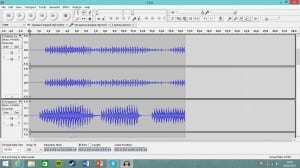The process through which we have gone has been quite difficult thus far. Attempting to build something in a space that isn’t a workshop requires us to seek out a lot of materials we need, providing difficulties. However, throughout the weeks, there has been a development in our piece: we have gone from wanting to build a scale model of the library and focusing on the history and architecture of the library, to building shelves in the quietest way possible and me monitoring this by microphones around the room; this would also provide a live soundtrack or soundscape of a workshop for the audience to listen as they watch from outside of the Freezone.
Within the workshop, we intend to have a few different things going on at the same time: sawing, hammering, sanding and varnishing. The microphones will be pointed at each of these and connected to a mixing desk which will in turn feed to headphones for the audience to listen to. On the mixing desk, I shall be attempting to make the things you might not hear over others; for example, sawing over hammering, so hopefully, the outcome will be that the live soundscape will provide the audience with sounds they might not necessarily think of hearing or listening to.
When you think of where a workshop tends to be, many people may class this as noise pollution because pf all the sawing and cutting and hammering that many people would class as a collective noise rather than individual sounds. However, ‘noise pollution results when we do not listen carefully. Noises are the sounds we have learned to ignore.’ (Kelly, 2011, 110) so by using the mixing desk, the audience will be able to listen carefully to what is happening in front of them. Also, ‘the concept of the soundscape is a broad one, accommodating the complete sound environment in a location and the human response to it.’ (Davies et al, 2013, 224) This is where the headphones come in. As no one but us will be allowed in the room, then the only way for people to hear what is going on will be through the headphones and they will be hearing the ‘complete sound environment’ (Davies et al, 2013, 224) of this workshop environment we will be creating.
Andrew Brooks
Davies, W.J, Adams, M.D, Bruce, N.S, Cain, R, Carlyle, A, Cusack, P, Hall, D.A, Hume, K.I, Irwin, A, Jennings, P, Marselle, M, Plack, C.J, Poxon, J. (2013) Perception of soundscapes: An interdisciplinary approach. Applied Acoustics. 74 (2) 224-231.
Kelly, C. (eds) (2011) Sound. London: Whitechapel Gallery.


![photo_1[1]](https://sitespecific2015dhu.blogs.lincoln.ac.uk/files/2015/03/photo_11-229x300.jpg)
![photo_4[1]](https://sitespecific2015dhu.blogs.lincoln.ac.uk/files/2015/03/photo_41-190x300.jpg)
![photo[1]](https://sitespecific2015dhu.blogs.lincoln.ac.uk/files/2015/03/photo1-242x300.jpg)
![photo_1[2]](https://sitespecific2015dhu.blogs.lincoln.ac.uk/files/2015/03/photo_12-225x300.jpg)
![photo_4[1]](https://sitespecific2015dhu.blogs.lincoln.ac.uk/files/2015/03/photo_411-300x195.jpg)
![photo_2[1]](https://sitespecific2015dhu.blogs.lincoln.ac.uk/files/2015/03/photo_211-219x300.jpg)
![photo_3[1]](https://sitespecific2015dhu.blogs.lincoln.ac.uk/files/2015/03/photo_311-300x220.jpg)